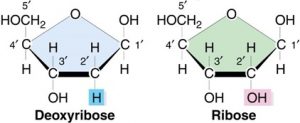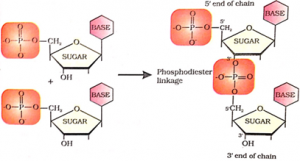Definition:
⇒ The particles in nucleus of a cell, responsible for heredity, are called chromosomes which are made up of proteins and nucleic acids.
⇒ Nucleic acids are long chain polymers of nucleotides, so they are also called polynucleotides.
⇒ Examples: Deoxyribonucleic acid (DNA) & Ribonucleic acid (RNA).
Chemical Composition of Nucleic Acids:
⇒ Each nucleotide has three components: a 5 – carbon sugar, a phosphate group, and a nitrogenous base.
⇒ In DNA molecules, the sugar moiety is β – D – 2 – deoxyribose where as in RNA molecule, it is β – D – ribose. ⇒ DNA contains four bases viz. adenine (A), guanine (G), cytosine (C) and thymine (T).
⇒ DNA contains four bases viz. adenine (A), guanine (G), cytosine (C) and thymine (T).
⇒ RNA also contains four bases, the first three bases are same as in DNA but the fourth one is uracil (U).
Structure of Nucleic Acids:
⇒ A unit formed by the attachment of base to 1’ position of sugar is known as nucleoside, the sugar carbons are numbered as 1’, 2’, 3’, etc. in order to distinguish these from bases. When nucleoside is linked to phosphoric acid at 5’ – position of sugar moiety we get a nucleotide. ⇒ Nucleotides are joined together by phosphodiester linkage between 5’ and 3’ carbon atoms of pentose sugar.
⇒ Nucleotides are joined together by phosphodiester linkage between 5’ and 3’ carbon atoms of pentose sugar. ⇒ A simplified version of nucleic acid chain is as shown below.
⇒ A simplified version of nucleic acid chain is as shown below.
\(-\overset{Base}{\mathop{\overset{|}{\mathop{Sugar}}\,}}\,-Phosphate-{{\left[ \overset{Base}{\mathop{\overset{|}{\mathop{Sugar}}\,}}\,-Phosphate \right]}_{n}}-\overset{Base}{\mathop{\overset{|}{\mathop{Sugar}}\,}}\,-\)
⇒ Information regarding the sequence of nucleotides in the chain of nucleic acid is called primary structure. Nucleic acids have a secondary structure also.
⇒ James Watson and Francis Crick gave a double strand helix structure for DNA. Two nucleic acid chains are wound about each other and held together by hydrogen bond between pairs of bases.
⇒ These are complementary to each other because the hydrogen bonds are formed between specific pairs of bases. DNA Fingerprinting:
DNA Fingerprinting:
⇒ Every individual has unique fingerprints.
⇒ A sequence of bases on DNA is also unique for a person and information regarding this is called DNA fingerprinting.
⇒ It is same for every cell and cannot be altered by any known treatment.
Uses of DNA finger printing:
i) In forensic laboratories for identification of criminals.
ii) To determine paternity of individual
iii) To identify racial groups to rewrite biological evolution.
Biological functions of Nucleic acids:
⇒ DNA is the chemical basis of heredity and may be regarded as the reserve of genetic information.
⇒ DNA is responsible for maintaining the identity of different species of organisms over millions of years.
⇒ A DNA is capable of self-duplications during cell division and identical DNA strands are transferred to daughter cells.
⇒ Nucleic acids are responsible for protein synthesis in the cell.
